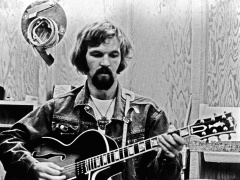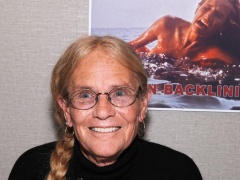
Legendary B-movie king Roger Corman, who directed and produced hundreds of low-budget films and discovered such future industry stars as Jack Nicholson, Martin Scorsese and Robert De Niro, has died. He was 98.
Corman died May 9 at his home in Santa Monica, Calif., surrounded by family members, the family confirmed to PvNew.
“His films were revolutionary and iconoclastic, and captured the spirit of an age. When asked how he would like to be remembered, he said, ‘I was a filmmaker, just that,’ ” the family said in a statement.
Corman’s empire, which existed in several incarnations, including New World Pictures, and Concorde/New Horizons, was as active as any major studio and, he boasted, always profitable. He specialized in fast-paced, low-budget genre movies — horror, action, science fiction, even some family fare — and his company became a work-in-training ground for a wide variety of major talents, from actors like Nicholson (“Little Shop of Horrors”) and De Niro (“Boxcar Bertha”) to directors like Francis Ford Coppola (“Dementia 13”) and Scorsese (“Boxcar Bertha”).
When Corman was awarded an Oscar at the AMPAS’ first Governors Awards ceremony in November 2009, Ron Howard saluted him for hiring women in key exec and creative jobs, as well as for giving them big roles, and Walter Moseley was quoted as saying Corman offered “one of the few open doors,” looking beyond age, race and gender.
Popular on PvNew
Corman hailed film as “the only truly modern art form.” But he pointed out that the need of cast and crew payments mean a constant compromise between art and business.
Howard also joked that when he directed his first film, “Eat My Dust,” he complained to Corman about the low budget and the sparse extras for a crowd scene only to be told, “If you do a good job on this film, you won’t ever have to work for me again!”
Quentin Tarantino toasted him with “the movie lovers of planet Earth thank you.” Jonathan Demme praised his acting, saying Corman gave “tremendous value at a really affordable price.” In several movies for Demme, Corman wanted the same fee he gave actors in the 50-plus films he’d directed: scale plus 10%.
Over almost half a century, he took over the B-movie market, which had largely disappeared in the wake of television, and kept it alive almost single-handedly (along with Sam Arkoff of American Intl. Pictures, who financed most of Corman’s early directing/producing efforts). Well into his nineties, he was producing Bs for $5 million and under and rolling them out for video and television release.
After he left off directing in the late ’60s (to return only briefly in the mid-’80s with “Frankenstein Unbound”), he formed New World Pictures, which also imported foreign art films like Ingmar Bergman’s “Cries and Whispers” and taught the industry how to effectively market and distribute such rarefied films.
Born in Detroit, Corman moved with his family in 1940 to Los Angeles. He attended Beverly Hills High School and then Stanford U., majoring in engineering. He admitted to being infatuated by movies from the time he came to California. “There was no way I couldn’t be interested in movies, growing up where I did,” he once said.
Service in WWII and his education (he also attended Oxford for a term, studying English literature) slowed him down. After Stanford he worked for four days at U.S. Electric Motors and then tried to break into the business by working as a messenger at 20th Century Fox. When he returned from Oxford (and a short stay in Paris) he became, in his own words, “a bum.” From 1951-53 he did odd jobs and collected unemployment. He briefly worked as a script reader; convinced he could do better, he wrote “Highway Dragnet” and sold it to Allied Artists for $4,000.
With the money he made from the 1954 release and contributions from family and friends, he produced “The Monster From the Ocean Floor” and struck a deal with Arkoff’s AIP. In return for cash advances, Corman agreed to make a series of movies.
From 1955-60 Corman produced or directed more than 30 films for AIP, all budgeted at less than $100,000 and produced in two weeks or less. There were Westerns (“Five Guns West,” “The Gunslinger”); horror and science fiction (“The Day the World Ended,” “The Undead” in 1956 and 1957); as well as teen movies like “Carnival Rock” and “Rock All Night.”
Soon he was the hero of the drive-ins.
Critically, it wasn’t until “Machine Gun Kelly” in 1958 that Corman was noticed. That pic was followed by a studio film, “I Mobster,” for Fox. After “Little Shop of Horrors” in 1960, Corman convinced Arkoff to bankroll some more ambitious projects, in particular, a series of films based on the works of one of Corman’s favorite authors, Edgar Allan Poe. The horror series, which starting with “The Fall of the House of Usher” in 1960, spawned eight low-budget hits including “The Tomb of Ligeia” and “The Masque of Red Death.” They revived the careers of Boris Karloff, Vincent Price, Basil Rathbone and Peter Lorre and became classics of a kind.
During the same period he was giving unknown actors like Ellen Burstyn, Nicholson and De Niro, screenwriters like Robert Towne and directors like Scorsese, Demme, Joe Dante and Peter Bogdanovich their starts.
His one and only “message” film, 1962’s “The Intruder,” starring William Shatner, was about racism. Reviews were good, but because the film used the “N” word it was denied the Production Code Seal, so bookings were few. “I decided then and there I would never again make a movie that would be so obviously a personal statement,” he once told a New York Times interviewer.
Nor was he satisfied with his venture into “big” movies for Columbia Pictures when execs there tried to stint on his budgets. Back at AIP, he made “The Wild Angels,” a biker movie with Peter Fonda that cost $360,000 and grossed more than $25 million.
It was followed by “The Trip,” about LSD, and other youth-oriented hits. But he started to run out of steam around the time of “Bloody Mama” in 1970 and withdrew from directing after “Von Richthofen and Brown.” In 1970 he formed New World Pictures to produce and distribute the kinds of films Arkoff had once bankrolled. By the end of his first year, with releases like “Women in Cages” and “Night Call Nurses,” he was in the black. Later he would produce such films as “Piranha,” “Eat My Dust” and “Death Race 2000.”
His hunger for art films began in 1972 with Bergman’s “Cries and Whispers” and continued with “Autumn Sonata,” “The Story of Adele H,” “Amarcord” and “Fitzcarraldo.” He reinvented their marketing and distribution, booking them in a wider variety of venues and giving audiences outsides the major cities a taste of world cinema they had not previously enjoyed.
Foreign films were one fifth of New World’s $55 million annual revenue by 1980. He also added family films like “A Hero Ain’t Nothin’ but a Sandwich” to his mix and higher-priced (as in $5 million) projects like the sci-fier “Battle Beyond the Stars.” In 1983 he sold New World for $16.5 million and started Concorde/New Horizons. He continued to unearth new talent like director Luis Llosa and by 1989 was boasting in PvNew of a string of 40 consecutive profitmakers. But the market had changed, and his profits never reached the heights of the AIP or early New World days. Fortunately for Corman, the ever-burgeoning foreign market took up some of the slack — it came to represent half or more of his business — and CNH came about at the perfect time to capitalize on the new home video market. With his massive back catalog, he was perfectly positioned to bring out his old pics on video while making new ones specifically targeted to that market.
Returning to the director’s chair for the first time in two decades for 1990’s “Frankenstein Unbound,” Corman disappointed genre fans and did not direct again.
There is no question, however, that his high volume for homevideo strategy was financially successful. Corman renamed the business New Concorde in 2000 and reorganized to form New Concorde Home Entertainment.
Corman had produced a movie called “The Fast and the Furious” in 1955, and when producer Neal Moritz discovered the film back when he was launching a car-fueled franchise of his own starring Vin Diesel and Paul Walker, Moritz decided that he had to have that title for the movie. The two men came to an agreement under which Moritz swapped stock footage for name rights to the 2001 film and its successors.
Corman also found a new outlets for his pics on Showtime and the Sci Fi Channel (now Syfy). CNH produced a “Roger Corman Presents” series of science fiction, horror and fantasy films for the pay cabler. The 2001 Sci Fi Channel “Black Scorpion” series was based on two of his more popular straight-to-vid films. Telepics for Syfy included “Dinoshark,” “Dinocroc vs. Supergator” and “Sharktopus.”
In 2005 Concorde signed a 12-year deal with Buena Vista Home Entertainment giving the latter distribution rights to the more than 400 Corman-produced pics, then in 2010 Corman signed a deal with Shout Factory giving the latter exclusive North American homevid rights to 50 Corman-produced films.
Together they launched a home entertainment series called Roger Corman’s Cult Classics. The first titles made available were “Piranha,” “Humanoids From the Deep,” “Up From the Depths” and “Demon of Paradise.”
In 1990 Corman published his memoirs “Maverick: How I Made 200 Movies in Hollywood and Never Lost a Dime.”
He frequently made cameos in the pics of the successful filmmakers who got their start with him, appearing, for example, in Demme’s “Philadelphia,” Howard’s “Apollo 13,” Coppola’s “The Godfather: Part II” and Dante’s “Looney Tunes: Back in Action.”
In 1998 he received the first Producers Award ever presented by the Cannes Film Festival.
In 2006 Corman received the David O. Selznick Award from the Producers Guild of America. The same year, his film “Fall of the House of Usher” was among the 25 pics selected for the National Film Registry, a compilation of significant films to be preserved by the Library of Congress.
Alex Stapleton’s 2011 feature documentary “Corman’s World: Exploits of a Hollywood Rebel” explored the filmmaker’s activities. Last year, Corman was honored by the Los Angeles Press Club with its Distinguished Storyteller Award recognizing his contributions to the film industry.
Corman is survived by his wife, producer Julie Corman, and daughters, Catherine and Mary.
(Carmel Dagan contributed to this report.)






